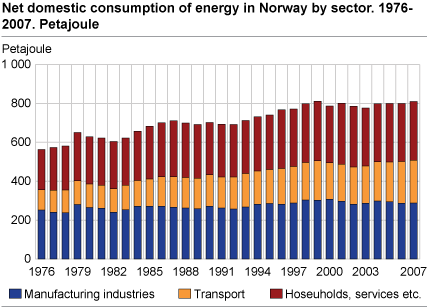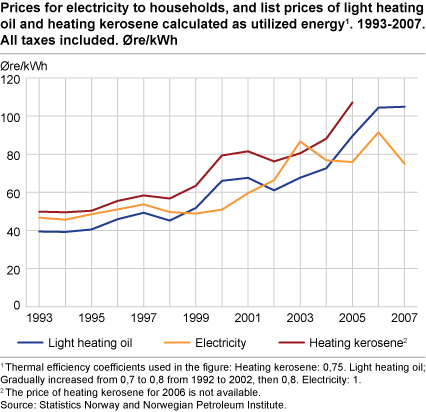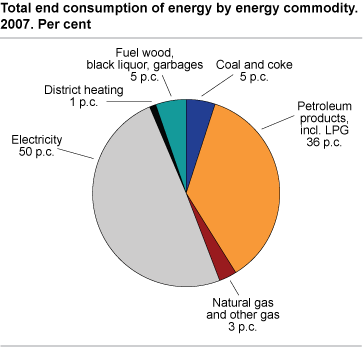Content
Published:
This is an archived release.
Energy consumption increases
Total energy consumption in Norway rose by about 1 per cent from 2006 to 2007, mainly due to higher overall electricity consumption and higher fuel consumption in transport. The increase in energy consumption for transport purposes follows a historical trend while the consumption is levelling out in other sectors.
Energy consumption for transport purposes increased by 2.5 per cent and now accounts for more than one quarter of the total end consumption of energy. The consumption of auto diesel in particular is increasing, while the use of gasoline has declined. In 2007, the use of gasoline was on about the same level as in 1980. This is partly due to the fact that diesel cars account for an increasing share of new car purchases, but it is also a result of increased transport of goods and public transport, mainly on diesel vehicles. Furthermore, the use of LNG (liquid natural gas) in boats was four times higher than in 2006, due to the fact that a large number of ferries use LNG. Nevertheless, LNG accounts for a small share of the energy used for transport purposes.
See separate article about natural gas
Increased sale of biodiesel
The sale of biodiesel is increasing, and was five times higher than in the previous year, with an increase from 7.1 million litres in 2006 to 39 million litres in 2007. There was also a strong increase from the first to the second half of 2007. Still, the total sale of biodiesel did not account for more than 1.6 per cent of the diesel used in road transport. About 9 per cent of this was sold as pure biodiesel, while the remaining was mixed into traditional diesel, with a share up to 5 per cent. The sale of bioethanol doubled from 2006 to 2007. However, this is less common than biodiesel, and only accounted for a few per thousand of the total sale of gasoline.
The increase in sales of biofuels is related to the Government’s goal of achieving a higher share of biofuels in fuels used in transport. Biofuels do not emit CO2 directly through use, and there are tax exemptions for the use of biofuels in diesel oil. Biofuels are also exempt from diesel taxes, but is more expensive to produce than traditional petroleum-based diesel. The Government has proposed to introduce legislation which makes it mandatory to mix at least 2 per cent biofuel in all fuels used in road transport from 2008, with an increase to 5 per cent in 2009.
Energy consumption in manufacturing industries is levelling out
Since 1998, the energy consumption in the manufacturing industry has fallen by 5 per cent, partly due to shutdowns of some large enterprises. In 2007, the energy consumption was approximately the same as in 2006. Energy intensive industries and production of paper and paper products account for about three quarters of the total energy consumption in the manufacturing industry, and this consumption was either unchanged or lower than in the previous year. However, the consumption in other industries rose by 3.5 per cent from the previous year. A change in the relative price difference between oil and electricity contributed to a 4 per cent drop in oil consumption in the manufacturing industry from 2006, while the electricity consumption rose.
Consumption also levelling out in other sectors
Within “other sectors”, which consists of households, service industries and construction, the energy consumption rose by slightly less than 1 per cent from 2006. The electricity consumption rose by 3.5 per cent from the previous year, while consumption of petroleum products and fuel wood fell by 4 and 9 per cent respectively. Electricity accounts for more than 70 per cent of the energy consumption in these sectors, which explains the increase in total consumption. The average electricity price for households was 75 øre/kWh in 2007, a sharp decline from the record level of 92 øre/kWh in 2006. The price of heating oil was almost unchanged from 2006, and relatively higher than the price of electricity. The total energy consumption in households, services etc has been relatively stable during the last decade, and is unchanged from 1998.
Lower temperatures
The increase in energy consumption from 2006 can partly be explained by lower temperatures. As in the previous 19 years (except from 1996), 2007 was warmer than normal. However, it was somewhat colder than in 2006. The temperature was 1.3 °C degrees above the normal in 2007, but 1.8 °C above the normal in 2006.
Less oil and more gas
The production of crude oil, NGL and condensate in 2007 fell to the lowest level since 1993, with 119 million tonnes in total. This is 9 per cent lower than in 2006. Still, the consumption of natural gas for energy purposes and flare burn off in oil and gas production rose by 13 per cent from 2006. This is due to higher production of natural gas. This production was more than three times higher than in 1993, and rose by 3 per cent from 2006 to 2007. Two new gas fields came on stream in 2007. Due to starting problems, the LNG production was lower and the flare burn off of natural gas higher than expected.
While the net domestic consumption of electricity has been almost unchanged in the last decade (1998-2007), the electricity consumption for oil and gas production has tripled in the same period. This is due to higher activity and the fact that some gas fields are supplied with electricity from the mainland.
Higher production of electricity
The production of electricity rose by about 13 per cent from 2006, and came to 137.7 TWh in 2007. Wind power accounted for 0.9 TWh, and increased by 34 per cent from 2006. The electricity consumption in Norway is mainly based on hydro power and the increase in total production is due to more precipitation and higher water reservoir levels. The increase in production resulted in net exports of electricity of about 10 TWh.
Norwegian gas production
Norway has been involved in gas power production for a long time, but mainly offshore and primarily to serve the oil and gas fields with electricity. Norway’s first commercial gas power plant was opened at the end of 2007. However, the price development of gas and electricity has contributed to low profitability and the production has so far been limited. Expected production is about 3.5 TWh per year.
Tables:
- Table 1 Energy sources balance sheet for Norway. 2007
- Table 2 Energy sources balance sheet for Norway. 2006
- Table 3 Energy balance sheet for Norway. 2007. Petajoule
- Table 4 Energy balance sheet for Norway. 2006. Petajoule
- Table 5 Net consumption of individual energy bearers. 1976-2007.
- Table 6 Energy balance, total energy 1998-2007. GWh
- Table 7 Energy balance, electricity only 1998-2007. GWh
The statistics is now published as Production and consumption of energy, energy balance and energy account.
Additional information
The statistics are published in spring and autumn. The spring publication is preliminary and aggregated to a larger degree, and only includes figures for energy balance. In the autumn publication, tables are also presented for the energy accounts.
Contact
-
Statistics Norway's Information Centre
E-mail: informasjon@ssb.no
tel.: (+47) 21 09 46 42



